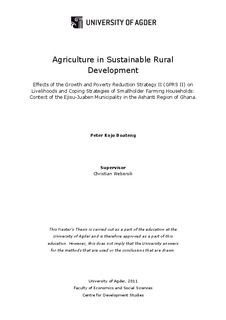| dc.description.abstract | The Poverty Reduction Strategy (PRS) approach championed by the World Bank and the
International Monetary Fund lies at the centre of development assistance, debt relief, and
development planning in many developing countries, including Ghana. Ghana has
implemented a PRS (Ghana Poverty Reduction Strategy I, 2003-2005) and a second
generation of PRS (Growth and Poverty Reduction Strategy II, 2006-2009) had just passed its
implementation phase in 2009. This study focuses on the second PRS – that is the Growth and
Poverty Reduction Strategy II (GPRS II). The study also selectively reviews major literature
on the role of agriculture in sustainable rural development and offers critical perspectives on
realising the potential multiplier effects of sustainable agriculture in sustainable rural
development promotion.
In Ghana, agriculture continues to be one of the dominant sectors of the economy, in terms of
its contributions to output, employment, revenue generation, and foreign exchange earnings,
and yet many of the poorest in Ghana, like in many developing countries, are farmers usually
practising smallholder rain-fed systems which are highly vulnerable to shocks. Meanwhile,
the specific nature of thematic areas of the GPRS II such as improving agricultural
productivity and its effects on livelihoods of poor and vulnerable groups such as food crop
farmers has received little academic attention. This study responds to this gap by offering a
theoretically informed empirical research directed towards the better understanding of the
effects that the agricultural productivity sub-sector of the GPRS II has had on smallholder
farmers’ ability to develop sustainable livelihoods. Often, variability in climatic conditions
interacts with adverse socio-economic conditions such as disadvantageous terms of trade and
poor agricultural infrastructure to undermine agricultural productivity and by extension,
farmers’ livelihoods (Sagoe, 2006).
The study adopted an analycentric approach to policy analysis of the GPRS II focusing on the
micro-scale of typically farming communities in the Ejisu-Juaben municipality of the Ashanti
region of Ghana. Livelihood analysis conceptual and methodological frameworks were also
employed to assess the livelihood resilience building capabilities of local smallholder farmers
due to effects of the GPRS II. It was revealed that although many of the interventions in the
municipality’s action plan seemed to conform to the most critical empirical needs of local
farmers for resilient livelihood development, the GPRS II has not duly benefited the greater
majority of farmers in the municipality, and thus been slow in its poverty reduction processes.
A livelihood resilience analysis for instance revealed that although a few smallholder farmers
were able to develop productive capital assets and to build viable and sustainable livelihoods
through the activities of the GPRS II, a greater majority of smallholder farmers in the
municipality have not been able to adequately develop capital assets for more productivity,
hence maintaining extremely poor and vulnerable livelihoods. | en_US |
